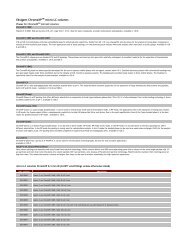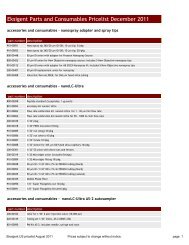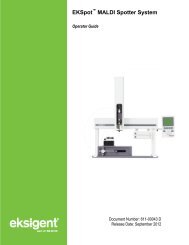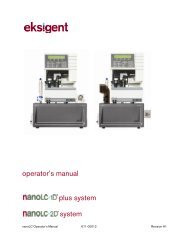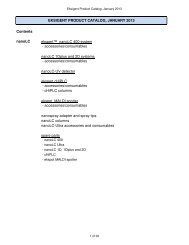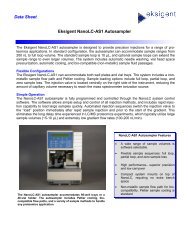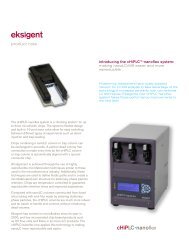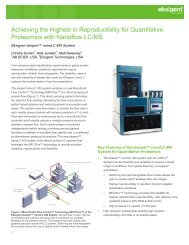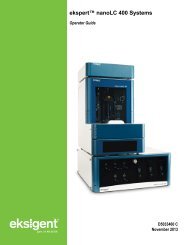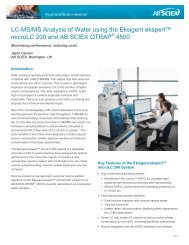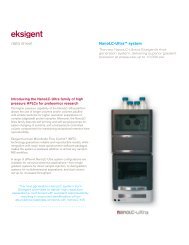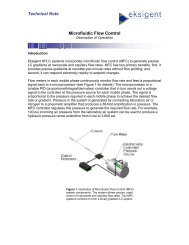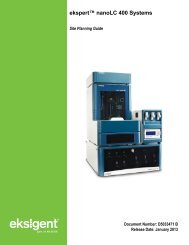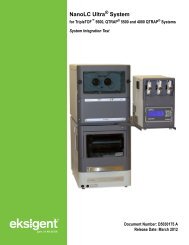N-linked Glycan Analysis using cHiPLC® System - Eksigent
N-linked Glycan Analysis using cHiPLC® System - Eksigent
N-linked Glycan Analysis using cHiPLC® System - Eksigent
You also want an ePaper? Increase the reach of your titles
YUMPU automatically turns print PDFs into web optimized ePapers that Google loves.
Experimental<br />
Sample Preparation: Underivatized N-glycan mixtures from<br />
bovine fetuin and human immunoglobulin G (IgG) (ProZyme,<br />
Hayward, CA) were used to test the two separation phases.<br />
Samples were freshly dissolved in 20% mobile phase A/80%<br />
mobile phase B solution for HILIC analysis and 100% mobile<br />
phase A for PGC separation.<br />
LC-MS/MS: An <strong>Eksigent</strong> NanoLC-Ultra ® 1D plus system<br />
(<strong>Eksigent</strong>, part of AB SCIEX Dublin, CA, USA) was used in<br />
combination with a cHiPLC ® system (<strong>Eksigent</strong>) in direct inject<br />
mode. The NanoLC-Ultra ® system delivers the solvent based on<br />
binary gradient pumps that use patented Microfluidic Flow<br />
Control (MFC) pump technology. The porous graphitic carbon<br />
(PGC) cHiPLC ® column was packed with 3 µm graphitized<br />
carbon. The hydrophilic interaction chromatography (HILIC)<br />
cHiPLC ® column contained 2.7 µm HALO Fused-Core particles<br />
as packing material (Advanced Materials Technology,<br />
Wilmington, DE, USA). The MS data was acquired <strong>using</strong> an LTQ<br />
ion trap mass spectrometer (Thermo Fisher, San Jose, CA,<br />
USA). Detailed experimental conditions were listed in Table 1.<br />
<strong>Glycan</strong> Separation Comparisons<br />
<strong>Glycan</strong>s are typically hydrophilic and thus not retained well by<br />
reversed phase liquid chromatography. Common alternative<br />
column phases include porous graphitic carbon (PGC) and<br />
hydrophilic interaction chromatography (HILIC). Both of these<br />
column phases retain hydrophilic compounds more than typical<br />
reversed phase chromatography and result in longer retention<br />
times vs. reversed phase LC. Therefore PGC and HILIC columns<br />
are often applied for resolving complex glycan mixtures.<br />
Figure 2. Extracted Ion Chromatogram of N-<strong>Glycan</strong>s Released from<br />
Bovine Fetuin <strong>using</strong> cHiPLC ® PGC Column. Compared to C18 phase,<br />
the PGC column retains the hydrophilic molecules much better and<br />
separates the positional isomers as well. The tetra-sialylated glycans are<br />
not separated as well as with the HILIC column (Figure 1), possibly due<br />
to their strong interaction with the PGC stationary phase.<br />
Figure 1 shows an example of <strong>using</strong> a HILIC-nanoLC/MS<br />
approach for the separation and detection of N-<strong>linked</strong> glycans<br />
from bovine fetuin. This particular sample contains a mixture of<br />
mono-, di-, tri-, and tetra-sialylated glycans, making the<br />
separation very challenging. Separation and identification of<br />
these N-glycans was also performed <strong>using</strong> a PGC cHiPLC ®<br />
column (Figure 2). One of the advantages of <strong>using</strong> PGC<br />
compared to HILIC is that the sample can be dissolved in high<br />
aqueous solutions to reduce sample loss. Bi-antennary and triantennary<br />
structures are well separated including the isomeric<br />
species. Compared to the HILIC cHiPLC column, the tetrasialylated<br />
glycans give broader peaks <strong>using</strong> the PGC column,<br />
Table 1. LC-MS Conditions for N-<strong>Glycan</strong> <strong>Analysis</strong>.<br />
HILIC Fetuin N-glycan PGC Fetuin N-glycan HILIC IgG N-glycan PGC IgG N-glycan<br />
Sample Concentration 2 ng/µL 2 ng/µL 20 ng/µL 2 ng/µL<br />
Injection Volume 1 µL 1 µL 1 µL 1 µL<br />
Column<br />
Halo HILIC cHiPLC ®<br />
75 µm x 15 cm<br />
PGC cHiPLC ®<br />
75 µm x 15 cm<br />
Halo HILIC cHiPLC ®<br />
75 µm x 15 cm<br />
PGC cHiPLC ®<br />
75 µm x 15 cm<br />
Mobile Phase A<br />
50mM ammonium formate<br />
pH 4.0<br />
0.08% ammonia<br />
pH 10.0<br />
50mM ammonium formate<br />
pH 4.0<br />
Water (0.1% formic acid)<br />
pH 4.0<br />
Mobile Phase B<br />
Acetonitrile<br />
(0.1% formic acid)<br />
Acetonitrile<br />
(0.1% formic acid)<br />
Acetonitrile<br />
(0.1% formic acid)<br />
Acetonitrile<br />
(0.1% formic acid)<br />
Temperature 60 °C 60 °C 60 °C 60 °C<br />
Detection LTQ, negative mode LTQ, negative mode LTQ, positive mode LTQ, positive mode<br />
Flowrate 300 nL/min 300 nL/min 300 nL/min 300 nL/min<br />
Gradient 70-60% B in 60 min 5-50% B in 30 min 90-60% B in 40 min 3-40% B in 40 min<br />
p 2



